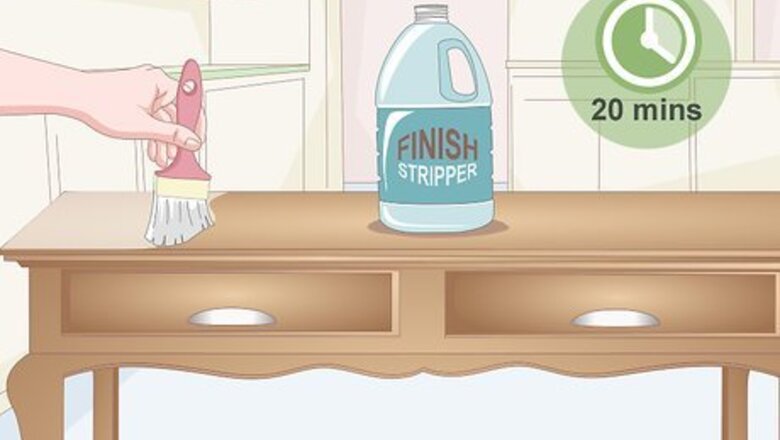
views
Bleaching the Wood

Apply finish stripper to the wood you want to lighten and let it sit for 20 minutes. Work in a well-ventilated area so you don’t breathe in any harmful fumes, and wear safety glasses and gloves to protect yourself. Dip a 2 in (5.1 cm) paintbrush with natural bristles into the finish stripper and paint it onto the wood that you’re lightening. Make sure you get even coverage of the area so it can strip the wood completely. Leave the stripper on the surface for 20 minutes so it has time to set. If you’re bleaching a wood floor, then you can apply chemical stripper or use a sander.
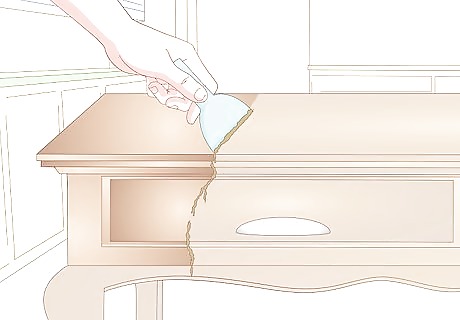
Scrape off the finish from the wood with a plastic scraper. Hold the scraper at a 45-degree angle to the piece of wood and apply a firm amount of pressure to lift up the old finish. Work along with the grain of the wood so you don’t scratch it or leave noticeable marks on the wood. Continue scraping the wood surface until you remove all of the old finish. Set out a drop cloth under your workstation so you can easily collect all of the old finish and throw it away. Scraping your finish off may also remove some of the stain on the wood.Tip: Wet the wood and check if it changes color evenly. If there is a spot that’s lighter or darker than the rest of the wood, there may still be some finish left on it.
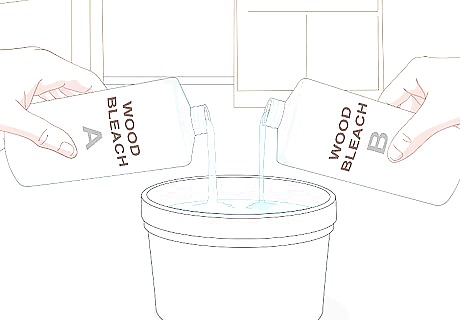
Mix together your wood bleach solution. When you want to bleach your wood, you can either use oxalic acid for a mild treatment or a 2-part wood bleach solution for a stronger treatment. Wear your safety glasses and gloves when you mix the bleach so you don’t get any irritation. If you’re using oxalic acid, mix the crystals in water following the directions on the package. If you’re using 2-part bleach, then pour equal amounts of both parts of the bleach in a small bowl and stir them together. Oxalic acid lightens the stain slightly and works best on naturally light woods. A 2-part bleach solution removes most of the color, and it also can lighten the natural color of dark wood. Both types of bleach will work on either oil-based or water-based stain. You can buy wood bleach and oxalic acid from hardware or home improvement stores.

Spread the bleach mixture onto your wood. Use a 2 in (5.1 cm) paintbrush to apply a thin coat of the bleach onto the wood. Make sure you get a thin application across the entire surface of the wood so it lightens evenly. After you put the bleach on, let it set for about 30 minutes so it can change the color of the wood and stain. If you’re applying the bleach to a wood floor, then use a mop to spread the bleach solution across the surface.
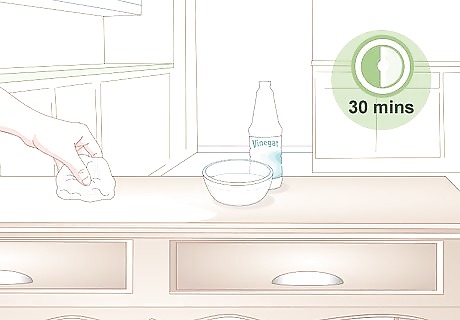
Neutralize the bleach with a white vinegar solution after 30 minutes. Combine equal portions of white vinegar and warm water in a large bowl or bucket, and stir it together. Dip a cleaning cloth in the solution and wring it out to remove the excess liquid. Wipe the wood surface with the vinegar solution to stop the reaction and prevent the stain from getting any lighter. You can neutralize the bleach at any time whenever you’re happy with the color.
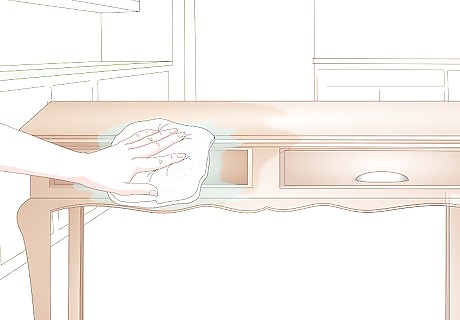
Wipe the wood clean with a wet cloth. Wet another cleaning cloth under your faucet with the warmest water possible. Wring out the excess liquid and then wipe your piece of wood clean. Be sure to clean every area to remove any bleach or vinegar that’s still on the surface. If you’re working on a wood floor, then use a mop with clean water to rinse the floor.
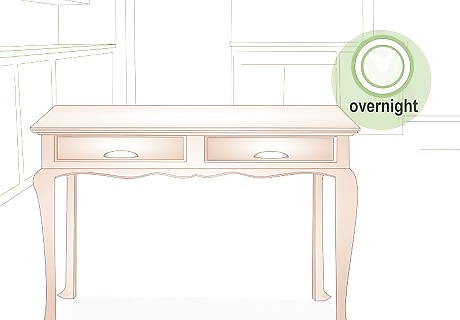
Let the wood dry overnight before judging the color. Leave the wood in a cool, dry place so the water can evaporate and so you can see the final color of the stain. Check the wood the next day to see if you’re happy with its color. If not, apply another bleach treatment on the wood the same way and check on it the next day to see if it’s lightened any more. Only use 2-3 bleach treatments on your wood since the color of the wood may start to look dull or grey.
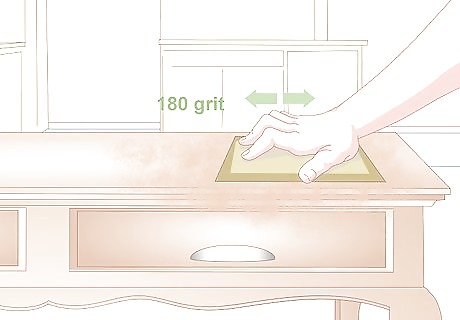
Sand the wood with 180-grit sandpaper. When you use a bleach treatment on wood, it removes some of the grain material, so sanding it will help level out your wood piece. Apply a firm amount of pressure with 180-grit sandpaper in the same direction as the wood grain so you don’t see any scratches. Keep using the sandpaper until the piece of wood is smooth to the touch.
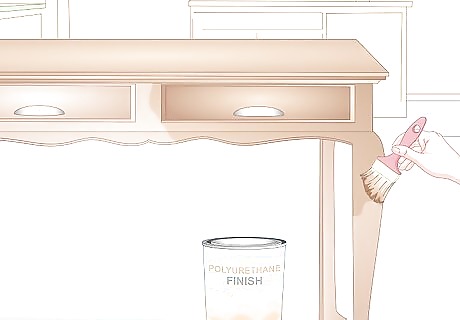
Apply a new finish to the wood to seal it. Look for a polyurethane finish for your wood, and stir it thoroughly to mix it. Use a 2 in (5.1 cm) paintbrush with natural bristles to paint a thin coat of the polyurethane on the wood, following the direction of the wood grain. After you spread the polyurethane out, pull your paintbrush over the area again in long strokes to remove any bubbles or uneven application. Don’t shake the can of polyurethane since it could form air bubbles on your wood and ruin the finish.
Lifting Stain with Steel Wool
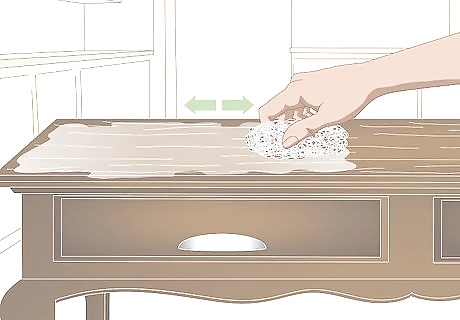
Rub steel wool against the wood in the same direction as the grain. Wet a piece of 0000 steel wool under warm water and wring out any excess liquid. Apply light pressure to the wood that you’re trying to lighten and work in long back and forth strokes in the direction of the grain. Be careful not to overlap the strips you rub with the steel wool since you could remove too much stain or material. The steel wool will scrape away small amounts of the stain and finish to lighten the wood. Only use super fine (0000) or extra fine (000) steel wool since you could remove too much material with coarse steel wool.Warning: Don’t rub against the grain since you’ll be able to see scratches in the wood.
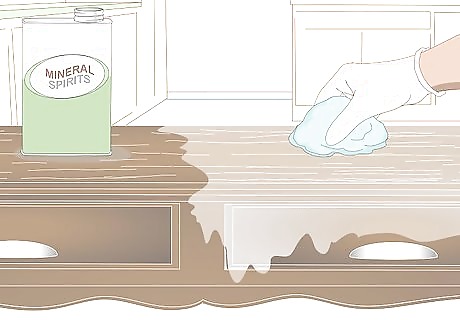
Wipe the wood with mineral spirits to help lift the wood stain. Put on safety glasses and gloves before handling mineral spirits since it could cause skin or eye irritation. Wet a shop cloth with the mineral spirits and wipe along the grain of your wood to lift up some of the stain. You will notice the wood getting slightly lighter than the rest of the stain. Continue wiping the area and change cloths if the first one gets too dirty. Work in a well-ventilated area since mineral spirits can create harmful vapors. Let the shop cloths dry completely before throwing them away since they could be a fire hazard. Steel wool and mineral spirits work best on oil-based stain, but it may work a little on water-based stain.
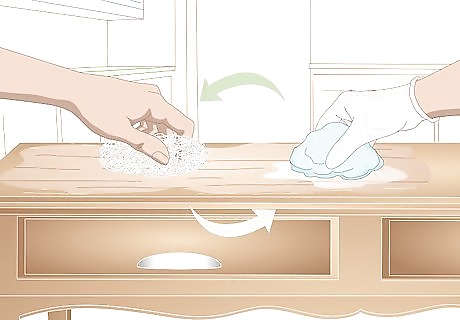
Alternate between the steel wool and mineral spirits until you’re happy with the color. Switch back to the steel wool and rub it gently over the wood surface again. After using the steel wool, wipe the area with mineral spirits again to remove some of the stain and lighten the color. Continue working until you’re satisfied with the wood’s color. Give the wood a final wipe with a clean cloth to remove any excess mineral spirits. Mineral spirits and steel wool will only slightly lighten the color of your stain, so it may take multiple applications to notice any changes. George Garrett George Garrett, Woodworking Expert When a wood stain turns out darker than desired, remedies range from sanding to bleaching. Start gently with steel wool to rub away excess pigment. If more lightening is needed, apply oxalic or citric acid. For dramatic brightening, reach for the hydrogen peroxide. Work slowly and safely while testing often, allowing the wood's natural beauty to emerge from the shadows.
Diluting Stain before Application
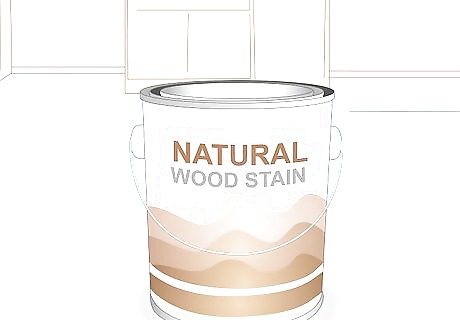
Get “natural” wood stain that has the same base as the stain you’re lightening. Natural wood stain is a transparent medium you can mix in with standard stain to make it thinner and lighten the color. Check the stain that you already have to see if it’s oil- or water-based so you know what type of natural stain to buy. Get the same amount of natural stain as the one you already have so you’re able to mix equal amounts. If you can’t find natural wood stain, you can also use mineral spirits for oil-based stains or water if it’s water-based.
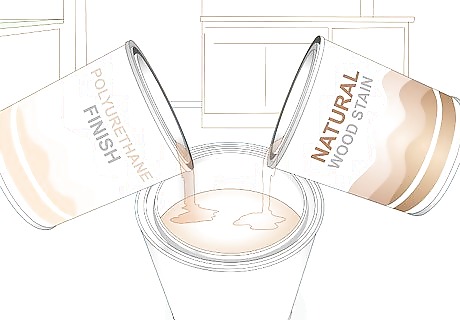
Combine equal parts of the stain you want lighter and natural wood stain. Use an empty paint can or another sealable metal container to mix your stain. Pour equal amounts of your stain and the natural stain into the container and mix it together with a paint stirrer. Continue stirring the stain together until it’s thoroughly combined or else it may appear spotty. You can buy empty paint cans from hardware stores or online.
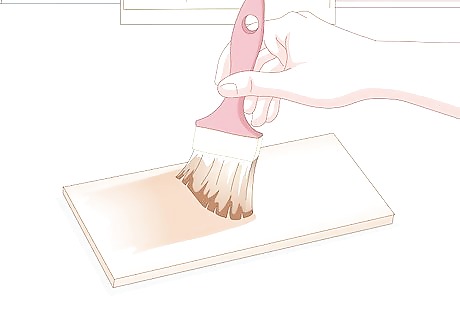
Test the stain on a scrap piece of wood to see the color. Dip the end of a paintbrush into the stain you just mixed and wipe off any excess on the rim of the paint can. Spread the stain on a scrap piece of wood that’s the same type you plan on staining later, and rub it into the wood with a shop cloth. Wipe any excess stain off of the wood, and look at the color of the stain compared to the natural wood to see if you’re happy with how light it is. The color when you first add the stain may be different than when it’s completely dry. Let it sit overnight so you can see what the wood looks like once it’s dry.Tip: Apply the original stain color on the wood next to the stain you have already diluted. That way, you can directly compare them to see how much you’ve lightened it.

Mix in more natural stain if you want the color lighter. If you still want to make your stain lighter, add ⁄2 cup (120 ml) of natural stain at a time and stir it together with your stir stick until it’s thoroughly mixed. Test the color of the stain on your piece of scrap wood to see how it looks, and continue mixing if you need to. Otherwise, put the lid on the can so you can use it later. Keep track of how much natural stain you add so you can replicate the same color in the future. If your stain gets too light, add another ⁄4–⁄2 cup (59–118 ml) of the original.


















Comments
0 comment